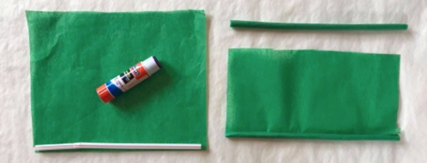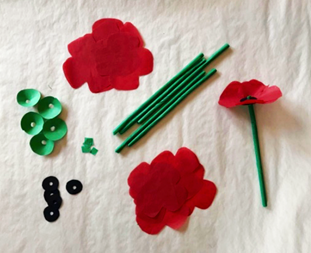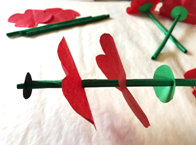Do you know how the poppy came to be the symbol of Remembrance Day and why we wear it each year on Memorial Day? This activity will help your children understand the importance of honoring the men and women who have given their lives in service to their country.
With this Memorial Day unit study you’ll be able to:
- Learn how the poppy serves as a symbol of remembrance for soldiers who gave their lives in World War I
- Read the text of two Memorial Day poems: ‘In Flanders Field’ by Lieutenant Colonel John McCrae and ‘We Shall Keep the Faith’ by Moina Mitchell
- Make your own tissue paper poppies
- Write a Memorial Day poem
Learn About the Poppy as a Symbol of Remembrance
From 1914 to 1918 Europe was ravaged the Great War which came to be known as World War I. The intense fighting left 8.5 million soldiers dead and forever changed the landscape of Western Europe. Some of the most intense fighting took place in northern France and Flanders, Belgium.
As deadly clashes between the Allied forces and the Central Powers marred the fields and forests, nevertheless in the spring of 1915 bright red poppy flowers began poking up through the battle-torn ground. The poppy seed can lie dormant in the ground for a long time, but when the soil is stirred, the seeds start to grow and produce brilliant red blooms. That spring when fighting disturbed the earth, poppies began to grow right on the battlefields.
Lieutenant Colonel John McCrae was a Canadian surgeon caring for the wounded after the Second Battle of Ypres when he noticed a cluster of poppies breaking through the scorched land. He was so struck by the contrast between the carnage of the battle in which 87,000 Allied forced were killed and wounded and the beauty of the tenacious red flowers that he penned the poem ‘In Flanders Field.’ In the poem McCrae gives voice to the fallen soldiers buried beneath the fields of poppies. The poem quickly became famous. By the time McCrae died in 1918 his poem was already being widely used in memorial ceremonies.
A few years later, just days before the Great War came to an end, an American woman, Moina Michael, read ‘In Flanders Field.’ McCrae’s poem inspired her to write her own tribute called ‘We Shall Keep the Faith.’ To honor the soldiers who had given their lives, Michael vowed to always wear a poppy as a symbol of their sacrifice. Over time she became known as “The Poppy Lady.”
Men and women on both sides of the Atlantic began making felt poppies and wearing them pinned to their clothes to remember those who died. A Frenchwoman named Anna Guerin organized a group of veterans, women and children to make and sell the poppies to raise money for the restoration of the country. In England she helped start a campaign to house and employ veterans of the Great War using funds raised through the selling of silk poppies. Other countries joined in.
In 1920 the American Legion adopted the poppy as their official flower to remember all the soldiers who fought and died during the war. They established National Poppy Day as the Friday before Memorial Day.
People still wear poppies every year in America on Memorial Day to remember those who have died in service to their country. Other Allied countries wear the poppy in autumn when they honor fallen soldiers on Remembrance Day.
Read ‘In Flanders Field’ and ‘We Shall Keep the Faith’
Download this free printable handout to read the two poems mentioned above in your homeschool. You’ll also find a summary of the poppy as a symbol of remembrance for your students to read.
Write a Memorial Day Poem of Your Own
After reading “In Flanders Field” and “We Shall Keep the Faith,” write your own poem about Memorial Day. It can include things about the war, poppies, how you celebrate Memorial Day today, and why you are thankful for all the men and women who fought for our country to give you the freedoms you enjoy.
Write it on the Memorial Day Poem Template!
Make Your Own Tissue Paper Poppies

Memorial Day is a day when we remember all the men and women who died fighting for our country to give us the freedoms that we enjoy. The poppy helps us to remember their sacrifice. You can make 5 poppy flowers to decorate your home and remind you of all the men and women who died to protect our country.
Materials:
- Tissue paper (green and red)
- Construction paper (black and green)
- Straws
- Glue stick
- Scissors
- Pencil
- Single hole punch
- Small vase or mason jar
- Poppy flower template
Step One:
Cut 5 pieces of green tissue paper to match the length of your straws (about 6-8 inches high). Put glue on one side of the paper. Place the straw on the edge of the paper, and then roll it up to cover the straw with green tissue paper. Do this for all 5 straws to create your stems.

Step Two:
Print out the Poppy Flower Template (print it on cardstock if you have some as it will make it easier to trace). Cut out each piece, trace it on the correct color and type of paper 5 times, and cut them all out.
Trace and cut: 5 small squares of green tissue paper, 5 small circles of black construction paper, 5 circles of green construction paper, 5 big petals of red tissue paper and 5 small petals of red tissue paper.
Step Three:
Punch holes in the middle of all 5 black circles.
Cut a slit into each green circle, put some glue to the right of the slit and fold it over a tiny bit to create a cone. Punch a hole in the middle and run a pencil through the hole to make it a tiny bit bigger.

Gently fold your flowers in half and cut a small slit in the center of each one. Now all your pieces should be ready!

Step Four:
Slide the biggest petals on the stem first, then slide the smaller petals on top. Slide the black circle on as well. You may need to pinch the straw and fold it a bit to get the circle on. Slide the green cone on the bottom of the stem and push it all together. You can put a little glue inside the green cone to help hold the pieces and curve the petals. Put a little glue on the green square tissue paper and cover the top of the straw opening. Twist it around to stick down all the edges.

Make all 5 flowers this way.
Step Five:
Put your flowers in a vase or a mason jar and set them on the table to remind you and your family of the many sacrifices others have made so that we can be free today!
Enjoy this post? Read on, and sign up for our homeschool newsletter!